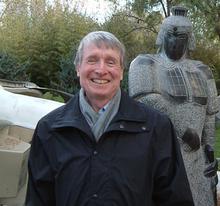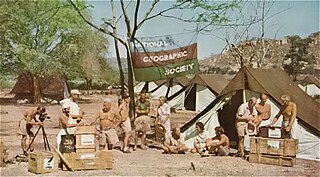Related Research Articles

Robert McCormick Adams Jr. was an American anthropologist and secretary of the Smithsonian Institution (1984–94). He worked in both the Near East and Mesoamerica. A long time professor of the University of Chicago, he was best known for his research in Iraq.

John Henry Holland was an American scientist and professor of psychology and electrical engineering and computer science at the University of Michigan, Ann Arbor. He was a pioneer in what became known as genetic algorithms.

John Desmond Clark was a British archaeologist noted particularly for his work on prehistoric Africa.

James Bennett Griffin or Jimmy Griffin was an American archaeologist. He is regarded as one of the most influential archaeologists in North America in the 20th century.

Robert John Braidwood was an American archaeologist and anthropologist, one of the founders of scientific archaeology, and a leader in the field of Near Eastern Prehistory.
Simon Asher Levin is an American ecologist and the James S. McDonnell Distinguished University Professor in Ecology and Evolutionary Biology and the director of the Center for BioComplexity at Princeton University. He specializes in using mathematical modeling and empirical studies in the understanding of macroscopic patterns of ecosystems and biological diversities.
Joyce Marcus is a Latin American archaeologist and professor in the Department of Anthropology, College of Literature, Science, and the Arts at the University of Michigan, Ann Arbor. She also holds the position of Curator of Latin American Archaeology, University of Michigan Museum of Anthropological Archaeology. Marcus has published extensively in the field of Latin American archaeological research. Her focus has been primarily on the Zapotec, Maya, and coastal Andean civilizations of Central and South America. Much of her fieldwork has been concentrated in the Valley of Oaxaca, Mexico. She is known for her "Dynamic model", four-tiered hierarchy, and her use of interdisciplinary study.
Henry Glassie College Professor Emeritus at Indiana University Bloomington, has done fieldwork on five continents and written books on the full range of folkloristic interest, from drama, song, and story to craft, art, and architecture. Three of his books -- Passing the Time in Ballymenone, The Spirit of Folk Art, and Turkish Traditional Art Today -- were named among the "Notable Books of the Year" by The New York Times. Glassie has won many awards for his work, including the Charles Homer Haskins Prize of the American Council of Learned Societies for a distinguished career of humanistic scholarship. A film on his work, directed by Pat Collins and titled Henry Glassie: Field Work, had its world premiere at the Toronto International Film Festival in 2019.

Robin B. Wright, is an American foreign affairs analyst, author and journalist who has covered wars, revolutions and uprisings around the world. She writes for The New Yorker and is a fellow of the U.S. Institute of Peace and the Woodrow Wilson Center. Wright has authored five books and coauthored or edited three others.

Kamyar Abdi is an Iranian anthropologist and assistant professor of archaeology at Shahid Beheshti University. He initiated his undergraduate studies in archaeology at the University of Tehran, leading to a master's degree. Subsequently, he joined the Oriental Institute based in the University of Chicago to study the near east civilizations and languages. Abdi holds his PhD in Anthropology from the University of Michigan, under supervision of Henry T. Wright. Prior to joining the Shahid Beheshti University in Tehran, he taught and researched in many institutions, namely Dartmouth College, Harvard University, University of California, Irvine and British Museum. He used to be a research associate at the Iranian Center for Research on Humanities and Cultural Studies, in addition to many editorial memberships in reputable journals, affiliation with councils and associations, and executive experiences such as leading the American Institute of Iranian Studies. He has carried out numerous extensive archaeological excavations in Iran, financially supported by domestic and international organizations. The outcomes of his research have played a major role in assisting the scientific community with resolving many questions pertinent to Iranian protohistory, calcolithic, Elamites and Achaemenids. Not only has he written several original publications, but also has translated many English books and articles into Persian, and keeps supervising graduate students.

The School for Advanced Research (SAR), until 2007 known as the School of American Research and founded in 1907 as the School for American Archaeology (SAA), is an advanced research center located in Santa Fe, New Mexico, U.S. Since 1967, the scope of the school's activities has embraced a global perspective through programs to encourage advanced scholarship in anthropology and related social science disciplines and the humanities, and to facilitate the work of Native American scholars and artists. SAR offers residential fellowships for artists and scholars, and it publishes academic and popular non-fiction books through SAR Press.
Anne St. Clair Wright (1910—1993) was an American historic preservationist. A central figure in the foundation, in 1952, of Historic Annapolis Incorporated, she served four terms as president and as chairman emeritus of the board. She was responsible for the preservation of the historic center of the city of Annapolis, Maryland. Her preservation work, advocacy and achievements inspired many preservation movements around the United States. She is considered a leading 20th-century American preservationist. Among many civic offices, she served as the director of the Society for the Preservation of Maryland Antiquities; chairman of the board of Preservation Action; was a member of the Mid-Atlantic Regional Advisory Committee of the U.S. National Park Service; director of the Southern Garden History Society; and a director of the Nature Conservancy.
Mark Paul Leone is an American archaeologist and professor of anthropology at the University of Maryland, College Park. He is interested in critical theory as it applies to archaeology and, particularly, to historical archaeology. He has directed Archaeology in Annapolis since 1981. This project focuses on the historical archaeology of Annapolis and Maryland's Eastern Shore and features the use of critical theory. Leone is committed to public interpretation and teaches his students about the relationship between public interpretation and the politics of archaeology.
The Gold Medal Award for Distinguished Archaeological Achievement is awarded by the Archaeological Institute of America in "recognition of a scholar who has made distinguished contributions to archaeology through his or her fieldwork, publications, and/or teaching."

Jeremy "Jerry" Arac Sabloff is an American anthropologist and past president of the Santa Fe Institute. Sabloff is an expert on ancient Maya civilization and pre-industrial urbanism. His academic interests have included settlement pattern studies, archaeological theory and method, the history of archaeology, the relevance of archaeology in the modern world, complexity theory, and trans-disciplinary science.

Wolfgang Fikentscher was a German jurist, legal anthropologist, and academic.
June Helm was an American anthropologist, primarily known for her work with the Dene people in the Mackenzie River drainage.

Frederick David McCarthy was an Australian anthropologist and archaeologist. He worked at the Australian Museum in Sydney and was Foundation Principal of the Australian Institute of Aboriginal Studies, with interests covering Australian archaeology, museology and Aboriginal rock art.
References
- 1 2 3 "Henry T. Wright". MacArthur Foundation. Retrieved 2019-10-16.
- ↑ Daemmrich, JoAnna (1993-09-20). "Anne St. Clair Wright, Annapolis preservationist". baltimoresun.com. Retrieved 2019-10-16.
- 1 2 "Gold Medal Award for Distinguished Archaeological Achievement". Archaeological Institute of America (AIA). 2009. Retrieved 2019-10-16.
- ↑ Faculty News. Vol. 16–19. University of Michigan (UM), College of Literature, Science, and the Arts (LSA). 1992. p. 78.
- ↑ Teltsch, Kathleen (1993-06-15). "A 1993 MacArthur Award Adds New Joy to a Singer's Hallelujahs". The New York Times. ISSN 0362-4331 . Retrieved 2019-10-16.